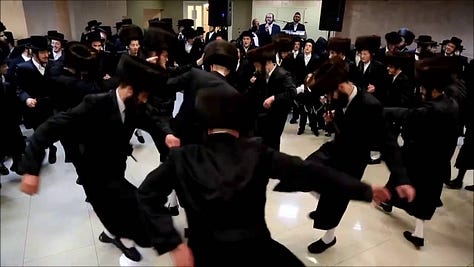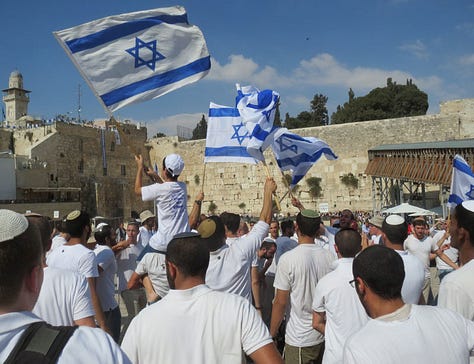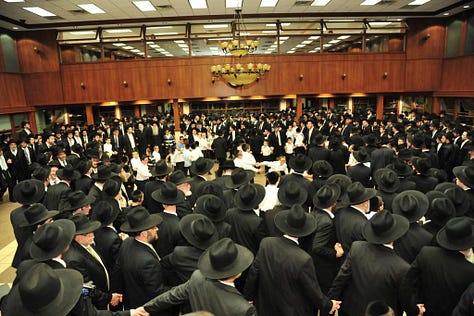The Gemara in Yoma (9b) is very clear when detailing the cause of the destruction of the second temple, it only gives one reason.
אֲבָל מִקְדָּשׁ שֵׁנִי שֶׁהָיוּ עוֹסְקִין בְּתוֹרָה וּבְמִצְוֹת וּגְמִילוּת חֲסָדִים, מִפְּנֵי מָה חָרַב? מִפְּנֵי שֶׁהָיְתָה בּוֹ שִׂנְאַת חִנָּם. לְלַמֶּדְךָ שֶׁשְּׁקוּלָה שִׂנְאַת חִנָּם כְּנֶגֶד שָׁלֹשׁ עֲבֵירוֹת: עֲבוֹדָה זָרָה, גִּלּוּי עֲרָיוֹת, וּשְׁפִיכוּת דָּמִים.
Beacuse the jewish nation was deeply invested in baseless hatred for one another. The Gemara wants to know why, even at a time when the early Tanaaim were alive, Torah was thriving in Israel, Mitzvos and Chesed were being preformed at a high level such destruction could occur. The gemara concludes that disunity is effectively counteracts whatever good is produced by limud Torah, Mitzvos, and acts of Chesed.
Josephus, in his 7-Volume account “The Jewish War” goes into great detail at the increasing disunity amongst the Jewish nation leading up to the destruction of the second Temple. So much so that he thought certain Jewsih leaders were actually causing more harm to the nation then the Romans themselves! One of the major issues broadly speaking was that Jews had split themselves into a bunch of little groups and were all fighting with eachother to the extent that some of the groups stopped considering themselves Jews. (This is a very general statement, I would highly recomend reading or listening to at least a summary to grasp the extent of the division plaguing Israel in the early first century CE.)
Throughout our history we have had periods of general togetherness and peace and at other times have fallen into pits of infighting and fracture. Today it seems we are plagued yet again, if not a baseless hatred per se more of a non-love. Yes, I think many of us are taught as children to “love every yid”, but on a very practical level what happens in the encounter with the “other type” or when we try to describe someone who we percieve as caring “too little” or “too much”, A Pas Nisht (Not for us) attitude. Unfortunately this prevailing attitude comes from the trauma suffered on us by the rise of the Haskalah movement. We are still being haunted by generation old issues. (You will notice that by the Sephardim this attitude is much less prevelant as the Haskalah did not intrude into those countries to the same extent that it did in Europe.)
The last major tragedy to occur to the Jewish nation was the Holocaust. Over 6 million Jews murdered in cold blood by the nationalist-socialist party of Adolf Hitler between 1939-1945. The Nazis made no distinction wether what you wore on your head was knit, velvet, or wether you wore anything at all. You were a Jew, and you were despised for it. No distinction was made between whether you subscribed to one Rosh Yeshiva over the other or to what Chasidus you belonged to, wether you kept Torah and Mitzvos or your family had been atheist for generations. We are all the same in the eyes of those that seek to destroy us. That counts for something.
I find that Tisha B’Av is a day to mourn over the apparent fragmentation in Klal Yisroel when it is obvious G-d makes no such distinctions. Even communities that in past decades used to overlap and have dialouge have since drifted farther apart than before. Modes of dress that used to signify a commitment to Judaism have solidified into uniforms of seperation between groups of commited Jews. At the end of the day, we may go to different schools or shuls or wear different colored clothing (quite laughable when its written out), we are from the same family. (many times literally, See these studies on Jewish genetics).
Something to think about is that although we may be vastly different from the non-religious elements in Judaism, there is still a bond that connects us and trying to sever it completely will only garuntee a failure of the redemption we would all like to witness so we can turn Tisha B’Av into the Yomtov it is supposed to be. I will finish with a beautiful pshat by Reb Eliezar Berkovits of the famous medrash in Vayikra Rabbah (30:12) :
דָּבָר אַחֵר, פְּרִי עֵץ הָדָר, אֵלּוּ יִשְׂרָאֵל, מָה אֶתְרוֹג זֶה יֵשׁ בּוֹ טַעַם וְיֵשׁ בּוֹ רֵיחַ, כָּךְ יִשְׂרָאֵל יֵשׁ בָּהֶם בְּנֵי אָדָם שֶׁיֵּשׁ בָּהֶם תּוֹרָה וְיֵשׁ בָּהֶם מַעֲשִׂים טוֹבִים. כַּפֹּת תְּמָרִים, אֵלּוּ יִשְׂרָאֵל, מָה הַתְּמָרָה הַזּוֹ יֵשׁ בּוֹ טַעַם וְאֵין בּוֹ רֵיחַ, כָּךְ הֵם יִשְׂרָאֵל יֵשׁ בָּהֶם שֶׁיֵּשׁ בָּהֶם תּוֹרָה וְאֵין בָּהֶם מַעֲשִׂים טוֹבִים. וַעֲנַף עֵץ עָבֹת, אֵלּוּ יִשְׂרָאֵל, מָה הֲדַס יֵשׁ בּוֹ רֵיחַ וְאֵין בּוֹ טַעַם, כָּךְ יִשְׂרָאֵל יֵשׁ בָּהֶם שֶׁיֵּשׁ בָּהֶם מַעֲשִׂים טוֹבִים וְאֵין בָּהֶם תּוֹרָה. וְעַרְבֵי נָחַל, אֵלּוּ יִשְׂרָאֵל, מָה עֲרָבָה זוֹ אֵין בָּהּ טַעַם וְאֵין בָּהּ רֵיחַ, כָּךְ הֵם יִשְׂרָאֵל יֵשׁ בָּהֶם בְּנֵי אָדָם שֶׁאֵין בָּהֶם לֹא תּוֹרָה וְלֹא מַעֲשִׂים טוֹבִים, וּמָה הַקָּדוֹשׁ בָּרוּךְ הוּא עוֹשֶׂה לָהֶם, לְאַבְּדָן אִי אֶפְשָׁר, אֶלָּא אָמַר הַקָּדוֹשׁ בָּרוּךְ הוּא יֻקְשְׁרוּ כֻלָּם אֲגֻדָּה אַחַת וְהֵן מְכַפְּרִין אֵלּוּ עַל אֵלּוּ, וְאִם עֲשִׂיתֶם כָּךְ אוֹתָהּ שָׁעָה אֲנִי מִתְעַלֶּה, הֲדָא הוּא דִכְתִיב (עמוס ט, ו): הַבּוֹנֶה בַשָּׁמַיִם מַעֲלוֹתָו, וְאֵימָתַי הוּא מִתְעֲלֶה כְּשֶׁהֵן עֲשׂוּיִין אֲגֻדָּה אַחַת, שֶׁנֶּאֱמַר (עמוס ט, ו): וַאֲגֻדָּתוֹ עַל אֶרֶץ יְסָדָהּ, לְפִיכָךְ משֶׁה מַזְהִיר לְיִשְׂרָאֵל: וּלְקַחְתֶּם לָכֶם בַּיּוֹם הָרִאשׁוֹן.
Another explanation: "The fruit of a beautiful tree" - these are [referring to] Israel. Just like this citron (etrog), which has taste and has smell, so too Israel has among them people that have Torah and have good deeds. "The branches of a date palm" - these are [referring to] Israel. Just like this date, which has taste and has no smell, so too Israel has among them those that have Torah but do not have good deeds. "And a branch of a braided tree (a myrtle)" - these are [referring to] Israel. Just like this myrtle, which has smell and has no taste, so too Israel has among them those that have good deeds but do not have Torah. "And brook willows" - these are [referring to] Israel. Just like this willow, which has no smell and has no taste, so too Israel has among them people that have no Torah and have no good deeds. And what does the Holy One, blessed be He, do to them? To destroy them is impossible, but rather the Holy One, blessed be He, said "bind them all together [into] one grouping and these will atone for those." And if you will have done that, I will be elevated at that time. This is [the meaning of] what is written (Amos 9:6), "He Who built the upper chambers in the heavens" (indicating his elevation). And when is He elevated? When they make one grouping, as it is stated (Ibid.), "and established His grouping on the earth." Hence Moshe warned Israel, "And you shall take for yourselves on the first day."
Reb Eliezar Berkovits:
Of each one of the four groups that the four plants symbolize it is said: eleh Yisrael, “such are Israel,” those without “Torah and good deeds” no less than those of “Torah and good deeds.” Looking at their division, G-d says: “To destroy them is not possible.” To destroy them all? Why should it occur to anyone to destroy even the masters of the Torah who also practice good deeds? Apparently, if there is no unity among them, G-d’s interest in all Jews diminishes. He wants the “one people on earth,” not a mere private holy society of saints. Even more surprising is the conclusion: “Let them all join together in unity and they will atone for each other.” That the men of “Torah and good deeds” atone for the people who are without them is understandable. But there is also an implication that those who are empty of “Torah and good deeds” will atone for those who are distinguished by them. How so? And why indeed would Torah scholars who practice good deeds be in need of atonement at all? It would seem that the rabbis believed that if there is no unity in Israel all are responsible, all are to be blamed.



I am aware that Josephus (just like any other historian) certainly had bias espessially because he was an employee of the roman government but nevertheless his accounts are generally considered the most accurate we have
The issue of “dress” or “uniform” in the context of religious affiliation is nuanced and requires an essay of its own.
There is obviously a discussion to be had over what boundries are and are not nececary to have when dealing with non-observant Jews, the main point is that the current “method” is untenable.
Rav Kook has a great qoute when he was asked why secular zionism was so successful, he answered: The fundamental moral force hidden in [the Zionist movement] ... is its motto, “the entire nation.” This nationalism proclaims... that it seeks to redeem the entire Jewish people. It does not concern itself with individuals or parties or sectors.... And with this perspective, it reaches out to the land of Israel and the love of Zion with a remarkable bravery and courage.”
“It is clear that we cannot confront this adversary if we lack the same noble sense of responsibility that speaks in the name of the entire nation, all of Israel. We may not distinguish and divide. We may not say, “This one is one of ours so we will take care of him, but not that one.” ... [We must] care in our hearts and souls for the good of the entire nation and its redemption, in the most inclusive way possible.”





Very nice. What speaks to me more than anything is when the Nazis Yimakh shemo equated us, and from their eyes our differences didn’t matter an iota. I would argue that there aren’t many times in history (even pre-haskala) where the unity was this strong. And like you said: maybe that should be the message; another reason we focus on the Holocaust during Tisha Be’av.
A different type of great talmudic personality, Rabbi Naftali Zvi Berlin, the head of the renowned yeshiva at Volozhin (second half of the 19th century), analyzes the concept of sin’at hinam, “causeless hatred,” in the service of a “good cause.” His comment is attached to a passage in the Talmud (Yoma 9b) that discusses the reasons for the destruction of the First and the Second Temples in Jerusalem. The First Temple was destroyed because of three sins: idolatry, sexual immorality and the spilling of innocent blood. During the Second Temple period, however, the Jews were occupied with the Torah, practiced the mitzvoth (divine commandments) and were charitable. Why then was the Temple destroyed? It happened because of sin’at hinam, causeless hatred.
However, this requires explanation. Why should people who live in accordance with the values of the Torah hate their fellow men? What, indeed, is causeless hatred? Rabbi Berlin explained it by interpreting two divine attributes. In Deuteronomy (32:4) God is described as being righteous and fair (straight, honest). What need is there to add the attribute of fairness? Does righteousness not include it? He explains that to be righteous is not enough, since it can go hand in hand with a lack of fairness in dealings with other people.
Such were “the righteous” during the era of the Second Temple. Whenever they saw a person conducting himself in a manner not in keeping with their own opinion of what constitutes “the fear of God,” they would immediately suspect him of being a heretic. This led them to enmity and hatred, even to bloodshed, until finally the Temple was destroyed. God punished these “righteous ones” for their lack of fairness. “Even though their intention was for the sake of Heaven, they caused destruction … and ruination” (Ha’amek Davar, introduction to commentary on Genesis). (More from R'Berkovits)